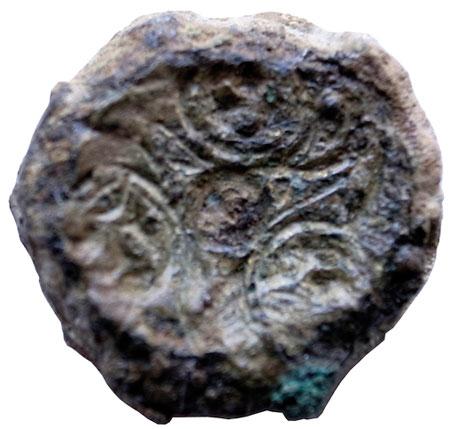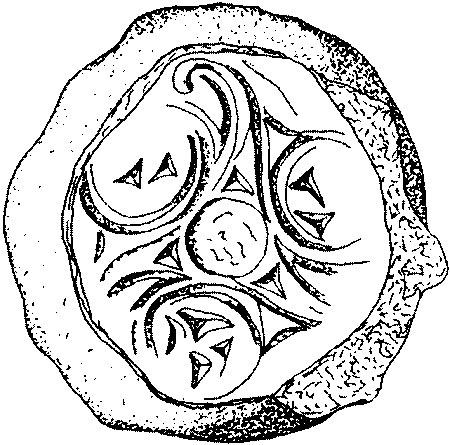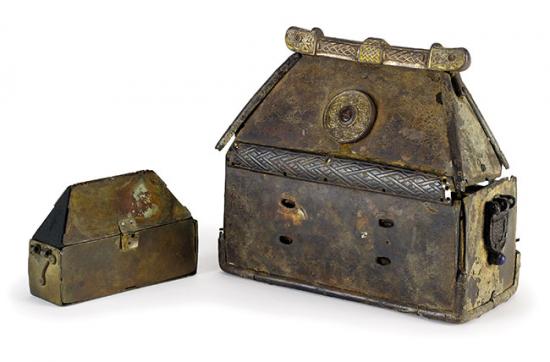PART.2
Weights tell of international relations

Foldable Norwegian balance scale, found in a barrow together with axe, sword and pliers. (Photo: from Rygh 1885)
Two of the mountings found in Denmark have different shapes from the other ones. One of them is square and the other is formed as a male mask. These may have been attached to a variety of objects, but cannot be as easily linked to specific church and monastery fixtures as the circular mountings.
These Irish weights with their ’foreign’ mountings therefore indicate lively contact with foreign shores in the Viking Age. This has been known for some time, especially from written sources that tell of the Vikings’ plundering and marauding behaviour towards their neighbours.
The interesting thing is that in recent decades we have seen an increasing number of metal-detector finds that further emphasize these relations. Out of the thousands of finds made every year by volunteers and amateur archaeologists, we occasionally come across rarities like these.
These weights tell us not only about the relations between the Vikings and their neighbours, but also about conflicts, since churches and monasteries were probably not very keen to let go of their valuable treasures.

Weight with Irish bronze mountings.

The drawing emphasizes the three-part composition of the ornamentation, which is a typical Irish feature. From the 8-9 century. (Drawing: Peter Vang Petersen)
Merchants needed to be ‘men of the world’
Recasting ’foreign’ decorative mountings into items other than weights is not an unknown phenomenon in Viking Age Scandinavia. We also know of other objects, especially brooches that used to be mountings but which have now been reworked.
This phenomenon is interesting in its own right, because why did people use these ‘recycled mountings’? Was it only because they were thought to be pretty and exotic, or could there perhaps be something more to it?
In international trading relations, there was a potential risk for everyone involved.
The trade could go wrong. One could end up being cheated, getting into trouble or perhaps even getting killed. So when trading with unknown people from distant shores, an additional element of uncertainty was added. There was no guarantee that the people you were trading with shared your worldview and your moral principles.
It was therefore important as a professional merchant to know a lot about many different peoples, so that you could trade successfully with various types of people.
Possessing such an intuitive understanding of different cultures gave the tradesmen a high social status, as this understanding was a prerequisite for much of the trading in the Viking era, which is characterised by extensive contact with the world outside Scandinavia.
Paradoxically, however, the weights with the Irish mountings, which originally ended up in Scandinavia as a result of a conflict, are regarded as a demonstration of the merchant’s extensive understanding of distant places and his ability to enter into trade relations with ‘strangers’.
Weights: important tools and great status symbols
The peculiar weights with the Irish mountings may have had two functions – in addition to their primary function as weights. They could partly signal the merchant’s status: “I am a merchant with some luxury items and access to these kinds of rarities.”
The weights could also signal to foreign people that this was a merchant who could do well outside of his own narrow circle: “I understand foreign cultures and am willing to trade under changing conditions.”
A trade is, in its simplest form, a meeting between two people in which a deal is made and items or services are exchanged. But it is also a meeting where there is an exchange of words and where cultures and opinions meet.

In 1892, a fisherman on the Irish Lake Lough Erne caught a fish, which managed to coil the fisherman’s line around a reliquary on its way up. The small shrine was found inside the larger one. Both are made from yew and covered with bronze. Note the mounting on the lid of the large shrine. (Photo: Irish National Museum, Dublin)
The specific traces only offer clues
It is extremely difficult – more than a thousand years after it took place – to speculate about such meetings. But the specific traces – the objects left behind by the Vikings – can give us a clue about some of the ideas and values that were in play at the time.
The ’Irish weights’ are a good example of this. These weights could add an extra layer of information to the traders – their international design could signal that the merchant was a man of the world, a man who could converse with foreign people, and that for a ’foreigner’ it was safe to trade with him. This merchant was willing to trade with foreign neighbours, who may have had values that were different from his own.
This may also be part of the reason why we sometimes find these very special objects from the Viking Age.
Translated by Dann Vinther